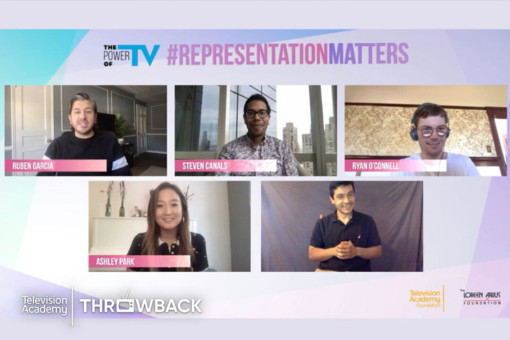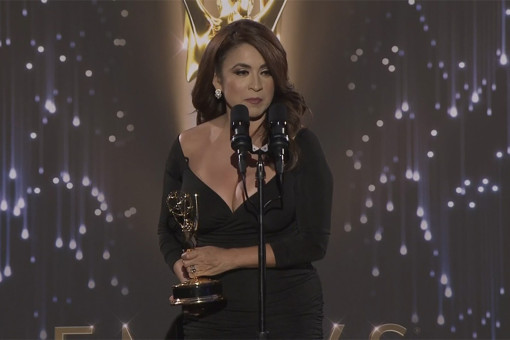The Television Academy today announced the recipients of the 73rd Engineering Emmy Awards honoring an individual, company or organization for developments in broadcast technology. Kirsten Vangsness, who starred for 15 seasons on the critically acclaimed CBS drama Criminal Minds, returns to host the awards for the sixth consecutive year on Thursday, Oct. 21, at the JW Marriott Hotel, Los Angeles, at L.A. LIVE.
This year Television Academy corporate partners Kia America and PEOPLE are sponsors of the Engineering Emmys.
Watch the video and see photos from the event.
"Engineers, scientists and technologists are a vital part of our industry and are key to the continuing evolution of television," said Frank Scherma, chairman and CEO of the Television Academy. "These extraordinary pioneers and groundbreaking companies we are honoring have advanced the medium and elevate storytelling to a worldwide audience."
"It has been a challenging year for the television production community; but despite the pandemic, production has come back and with it a host of new technologies that are being used to help the storytelling process," said Committee Chair John Leverence. "This year a wide range of technologies are being recognized. They run the gamut from high-end, computer-generated special effects to lighting enhancements; audio tools; script-note technology; and systems that help maintain distancing protocols."
The following is a list of awards and recipients to be recognized:
The Charles F. Jenkins Lifetime Achievement Award
Honors a living individual whose ongoing contributions have significantly affected the state of television technology and engineering.
Recipient: Reed Hastings
Reed Hastings, co-founder and CEO of Netflix, began revolutionizing how the world is entertained in 1997 when he conceived the idea of a subscription-based movie-rental service. The serendipitous cause of this lightbulb moment was an annoying late-return fee he incurred when he missed the deadline to return a store-rented videocassette. A decade after its origin sending DVDs through the mail, Mr. Hastings realized that internet television rather than the United States Post Office was a better way to distribute filmed entertainment. For developing game-changing algorithms that recommended programming to subscribers that track and reflect their viewing preferences, Netflix received the Academy's Engineering Emmy in 2012. The Netflix cloud infrastructure, cloud-based video encoding and encryption, cloud-based bookmarking, multiple-profile stream encryption, "Open Connect" content delivery network, adaptive streaming technology, dynamic app updates and personalization technologies deliver the service at scale with 99.99% availability. The major patent portfolio that Netflix has developed, combined with the scale of service delivery, widespread market use of the services and the validation of an alternative business model for television distribution is changing the television industry in fundamental ways. With these and other innovations in the way television content is conceived, produced, packaged, distributed and marketed, Mr. Hastings has positioned Netflix to significantly alter and to continue to affect the state of television technology and engineering.
The Philo T. Farnsworth Corporate Achievement Award
Honors an agency, company or institution whose contributions over time have substantially impacted television technology and engineering.
Recipient: Dolby Laboratories
Since its founding in 1965 by Ray Dolby, Dolby Laboratories has been a significant innovator and contributor to the television industry in audio and imaging technology. Early work involved the creation of the Dolby noise reduction system and Dolby Stereo, which improved the sound quality of music and film. As digital audio recording and distribution emerged, the family of Dolby Audio technologies became ubiquitously adopted for over-the-air broadcasting, streaming and physical disc distribution of television content. Recently, Dolby Atmos, providing an immersive sound experience, and Dolby Vision, providing more contrast, colors and brighter images with better specular highlights, have been brought to the home market. These technologies are not only accessible in high-end viewing rooms but are also available in typical home settings with televisions and sound bars, on tablets and personal computers with headphones, and on smartphones, becoming a standard for the highest-quality streaming experiences. These are but a few samplings of Dolby's innovations that have improved the quality of television storytelling for more than 50 years.
For more information, please visit dolby.com.
Engineering Emmys
Presented to an individual, company or organization for engineering developments that considerably improve existing methods or innovations that materially affect the transmission, recording or reception of television.
This year's eight (8) Engineering Emmy recipients are:
Recipient: Arnold Global Illumination Rendering System - Marcos Fajardo, Alan King, Thiago Ize
Arnold is a photo-realistic, stochastic, ray-tracing renderer widely used by visual effects and animation studios around the world. Taking an artist-friendly approach, Arnold faithfully simulates the light-transport equation at render time, without relying on problematic caching methods. Extensive scientific research, as well as algorithmic, system and low-level optimizations were required to reduce memory usage and render time. Its high-quality rendering and ease of use have resulted in its extensive use and popularity for television productions.
For more information, please visit autodesk.com.
Recipient: ARRI SkyPanel - ARRI
The ARRI SkyPanel is a family of ultra-bright LED soft lights. They are efficient, versatile lighting instruments with multiple control options. SkyPanels can generate accurate color temperatures between 2,800k and 10,000k with excellent color rendition over the entire range. Lighting directors can control all parameters including color, hue and saturation along with pre-programmed lighting effects. These fixtures have optimized the production lighting workflow and have been widely adopted throughout the television industry.
For more information, please visit arri.com.
Recipient: CEDAR Studio - CEDAR Audio Ltd.
CEDAR Studio was developed specifically to meet the needs of audio professionals in the field of film and television post-production. Originally comprising four processes, it has grown to provide a wide range of tools for cleaning and restoring audio. These include the industry-standard dialogue noise suppressors as well as Retouch, the process that introduced spectral editing to the industry. CEDAR Studio allows users to eliminate a wide range of problems and provides unsurpassed results quickly and efficiently.
For more information, please visit cedar-audio.com.
Recipient: Golaem Crowd - Golaem
Golaem Crowd helps artists to populate television shows, films and game cinematics in minutes by procedurally animating thousands of characters with advanced behaviors in real-time and with complete artistic control. Golaem functions permit automatic navigation of characters, path planning and steering behaviors, including reactive collision avoidance, in order to create realistic human behaviors. These features have resulted in Golaem becoming a ubiquitous tool in computer-generated character generation across the television industry.
For more information, please visit golaem.com.
Recipient: Massive - Stephen Regelous
Massive is a pioneering software package that first gave artists the ability to simulate crowds using an artificial intelligence-based approach. It enables artistic control with a cost-effective means to simulate realistic crowd behavior in a flexible fashion by building autonomous behavior via its node-based brain system. Massive has been used on many Emmy-winning shows and was the first package to make it possible to create large crowds at scale.
For more information, please visit massivesoftware.com.
Recipient: Scriptation - Steve Vitolo, Felipe A. Mendez P., Franco Zuccar
Scriptation automates the tedious process of transferring handwritten notes, annotations and verbal comments to a script and redistributing to all departments. Now all of the personal notes, annotations and diagrams carry over to new versions of the script and are redistributed automatically. Departments are now able to share their notes about the script with all other departments in one place, providing streamlined communications and better understanding of the overall script plan. Scriptation has become a popular application, adding efficiency through environmentally conscious workflows and clear communication in today's production environment.
For more information, please visit scriptation.com.
Recipient: Teradek Bolt 4K - Nicolaas Verheem, Marius van der Watt, Dennis Scheftner, Zvi Reznic
Teradek Bolt 4K is a zero-delay, wireless video transmission system for on-set monitoring, offering high-quality wireless video integrated into the workflow. Bolt 4K has been critical in implementing changes needed to support social distancing protocols. Today, tens of thousands of Bolt transmitters and receivers are working in the entertainment industry—owned by camera operators, digital imaging technicians, drone pilots, production companies and rental houses—to efficiently service all television productions.
For more information, please visit teradek.com.
Recipient: V-Ray - Chaos
Chaos' V-Ray is a physically based rendering and adaptive ray tracing solution used to create photo-realistic visual effects in episodic production since 2003. Optimized to handle large production scenes, V-Ray is used to render digital environments, digidoubles, creatures, vehicles and more in a highly efficient way. By accurately calculating global illumination and the distribution of light, as well as the physical properties of any material, the software ensures a seamless blend of real and virtual elements on screen.
For more information on Chaos, please visit Chaos.com.
About the 73rd Engineering Emmy Awards
The 73rd Engineering Emmy Awards are overseen by Committee Chair John Leverence and committee members Wendy Aylsworth; Stuart Bass, ACE; Bob Bronow, CAS; Jeff Calderon; Jim DeFilippis; Greg Gewickey; David Ginsberg; Frank Morrone, CAS; David Plakos; Jeffrey Riedmiller; Michael Ruscio; Leon Silverman; Derek Spears; David Stump, ASC; Craig Weiss; and Barry Zegel.
###
Stephanie Goodell
breakwhitelight (for the Television Academy)
Stephanie@breakwhitelight.com
818.462.1150
For the complete press release, click here.












